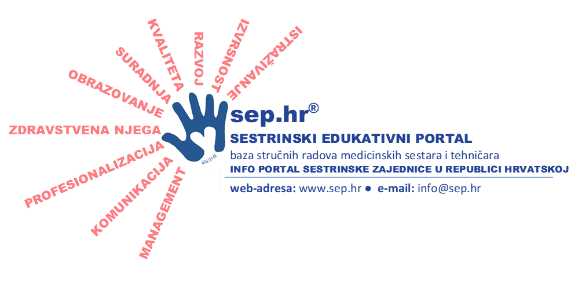Autori: Sofija Alijević
Ustanova zaposlenja: SERBIA
Ključne riječi: children’s, pain management, knowledge, implementation
Kongres/Simpozij: ”5. Međunarodni kongres HDMSARIST-a” i ”8. Međunarodni kongres WFCCN-a”
Mjesto i vrijeme održavanja: Šibenik, 12.-15. travnja 2012. godine
Introduction: The nature of pain, especially in children, is complex and is the result of Interaction of biological,psychological, social and spiritual factors that affect not only the child but also tohis family. Physical, mental and cognitive development of children is important when we examine his experience with the pain. Children do not develop in these three spheres at the same time, it also will not develop the same pace. These factors make the assessment of pain in a child especially a complex process that requires a multidisciplinary approach.
Methods: literature analysis, descriptive methods
Discussion and conclusion: The requirement to work in teams to apply the treatment of pain: Higher or university education, experience in working with severely ill children, prominent communication skills – good contact with the young patients and their parents, continuous further education. Considering the lack of spread of application of pain therapy in our country, especially in children, a nurse, together with a team needs to work to overcome the lack of knowledge about: pain, pain assessment, pain treatment. From her/his point of view, an experienced Nurse can contribute to an improved application of treatment of pain in our country: health educational work with patients who
have a deficit of knowledge about pain therapy, organizing seminars for Nurses on pain therapy within the institution and the whole country, collaboration with Nurses in Europe and the world, development and establishment of standards for the treatment of pain and regular revision, research in the field of pain therapy (on the level of knowledge of Nurses and the need for additional education, effectiveness of treatment, the level of the cooperation with parents and their information, the need for modernization and many other issues). Development of informational brochures for parents, customized and understanding education for all social categories, establishing
good interpersonal relationships in professional pain management team, organizing the flow of feedback between primary, secondary and tertiary care centers for better evaluation of pain therapy. Some of strategies for improvement of pain management are: 1 Development of organizational systems to ensure successful implementation. 2. Standardization guidelines in the work. 3.Standardization of pain therapy documentation. 4. To formulate the role of each team member.
5. Determination of expert resources that will be always available. 6. Education- multidisciplinary education for nurses.
